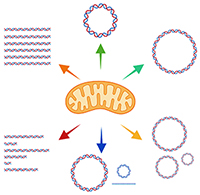Mitochondrial genomes – unity and diversity
DOI:
https://doi.org/10.18388/pb.2021_486Abstract
The emergence of mitochondria was one of the most important events in the history of life on Earth. The engulfed bacterial cell, transformed into a mitochondrion, retained its genome, which then underwent numerous modifications. Through massive loss and numerous gene transfers into the nuclear genome, the autonomous bacterium eventually evolved into the organelle we know today. As a result of changes taking place independently in different evolutionary lineages, we observe a great diversity of mitochondrial genomes with respect to structure and gene content. In most cases, mitochondrial DNA has a circular shape, but linear molecules of mitochondrial DNA are also observed in some eukaryotes. In extreme cases, such as in reduced mitochondrial-derived organelles, the genome has been completely lost. In this article, we discuss the diversity of mitochondrial genome structures within the largest groups of Eukarya.

Published
Issue
Section
License
Copyright (c) 2023 Maria Jagielska, Paweł Hałakuc, Magdalena Płecha, Rafał Milanowski

This work is licensed under a Creative Commons Attribution 4.0 International License.
All journal contents are distributed under the Creative Commons Attribution-ShareAlike 4.0 International (CC BY-SA 4.0) license. Everybody may use the content following terms: Attribution — You must give appropriate credit, provide a link to the license, and indicate if changes were made, ShareAlike — If you remix, transform, or build upon the material, you must distribute your contributions under the same license as the original. There are no additional restrictions — You may not apply legal terms or technological measures that legally restrict others from doing anything the license permits.
Copyright for all published papers © stays with the authors.
Copyright for the journal: © Polish Biochemical Society.



